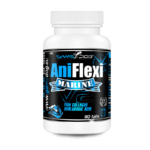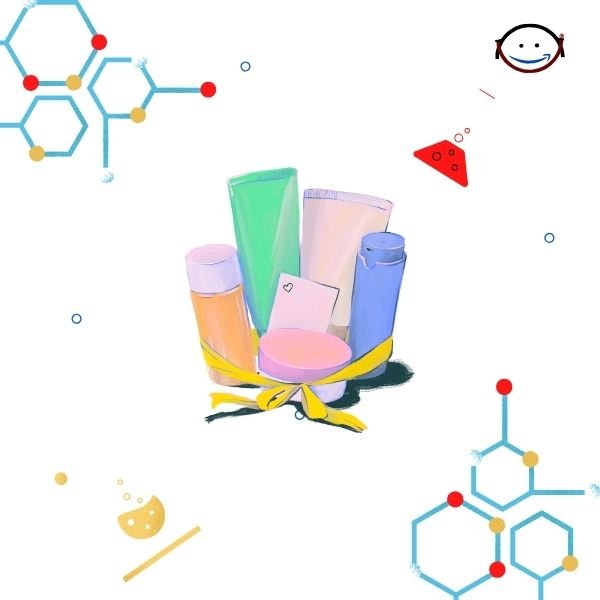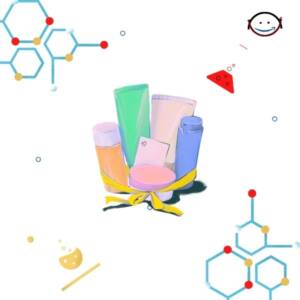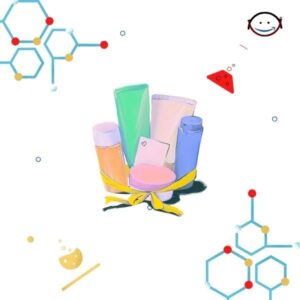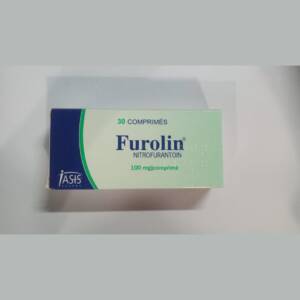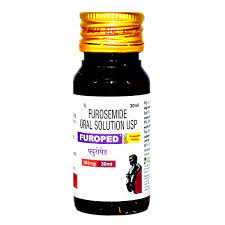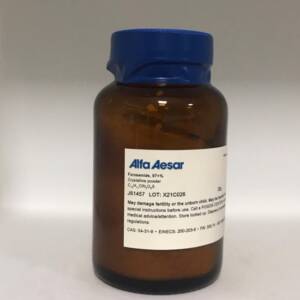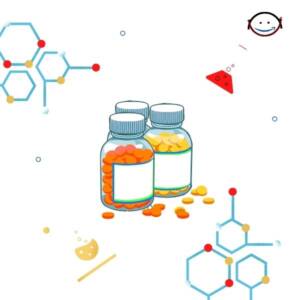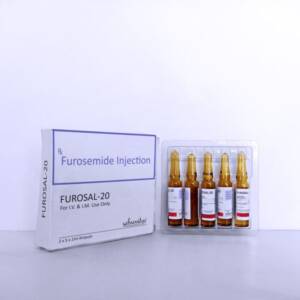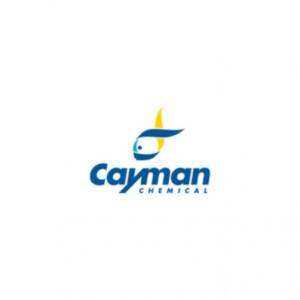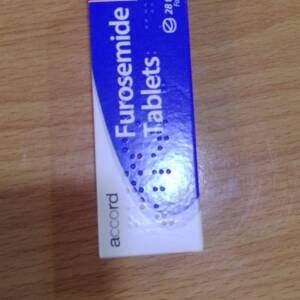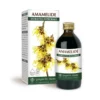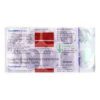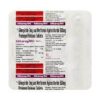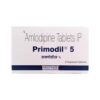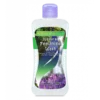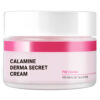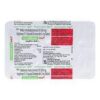-
Witch Hazel Integral Extract Dr. Giorgini 200ml ₦33,193.00 QTY: 1
-
DAPATURN M FORTE 5MG STRIP OF 10 TABLETS ₦2,580.25 QTY: 1
-
GABAPIN 400MG CAPSULE ₦6,105.00 QTY: 1
-
CUTIYT G2 30GM CREAM ₦13,488.75 QTY: 1
-
Sooft Italia Gangliomix Food Supplement 30 Tablets ₦55,898.00 QTY: 1
-
SMARTWAY VOMIPRO-MD TABLET (10 Tablets) ₦45.50 QTY: 1
-
GLITARAY M 3/500MG STRIP OF 10 TABLETS ₦3,896.00 QTY: 1
-
PRIMODIL 5MG TABLET ₦513.50 QTY: 1
-
PRACTOMET 1000MG SR STRIP OF 10 TABLETS ₦813.00 QTY: 1
-
NaturaCentials Feminine Wash ₦3,000.00 QTY: 1
-
Green World Vigpower Capsule ₦17,400.00 QTY: 1
-
HM100-Pro Thermo Mix For Magnetic Heating Blocks (not supplied with block) ₦584,500.00 QTY: 1
-
Natural Bamboo Toothbrush 10PCS Colorful Set ₦6,640.68 QTY: 1
-
GLYCIPHAGE VG2 TABLETS 10?S ₦3,181.50 QTY: 1
-
Polished London Teeth Whitening Strips - 14 Pack ₦99,800.00 QTY: 1
Customer matched zone "Lagos Delivery Options"
Sort by:
132081–132096 of 362918 Results
-
SaleFurocef 250 mgIt is indicated for the treatment of infections caused by sensitive bacteria. Pharyngitis/Tonsillitis caused by Streptococcus pyogenes. Acute Bacterial Otitis Media caused by Streptococcus pneumoniae, Haemophilus influenzae, Moraxella catarrhalis (beta-lactamase producing strains) or Streptococcus pyogenes. ... Read moreIt is indicated for the treatment of infections caused by sensitive bacteria. Pharyngitis/Tonsillitis caused by Streptococcus pyogenes. Acute Bacterial Otitis Media caused by Streptococcus pneumoniae, Haemophilus influenzae, Moraxella catarrhalis (beta-lactamase producing strains) or Streptococcus pyogenes. Acute bacterial maxillary sinusitis caused by Streptococcus pneumoniae or Haemophilus influenzae (non beta-lactamase producing strains) Lower respiratory tract infections including pneumoniae, caused by Streptococcus pneumoniae, Haemophilus influenzae (including beta lactamase-producing strains), Klebsiella spp., Staphylococcus aureus (penicillinase- and non-penicillinase-producing strains), Streptococcus pyogenes, E. coli Acute bacterial exacerbation of chronic bronchitis and Secondary bacterial infections of Acute bronchitis caused by Streptococcus pneumoniae, Haemophilus influenzae (beta-lactamase negative strains) or Haemophilus parainfluenzae (beta-lactamase negative strains). Skin and skin-structure infections caused by Staphylococcus aureus (including beta-lactamase producing strains) or Streptococcus pyogenes. Urinary tract infections caused by E.coli or Klebsiella pneumoniae. Bone and Joint Infections caused by Staphylococcus aureus (penicillinase- and non-penicillinase-producing strains). Gonorrhoea caused by penicillinase-producing and non-penicillinase producing strains of Neisseria gonorrhoeae. Early Lyme Disease (erythema migrans) caused by Borrelia burgdorferi. Theropeutic ClassSecond generation CephalosporinsPharmacologyCefuroxime is a well-characterized and effective antibacterial agent, which has broad-spectrum bactericidal activity against a wide range of common pathogens, including ?-lactamase producing strains. Cefuroxime has good stability to bacterial ?-lactamase and consequently, is active against many ampicillin-resistant and amoxycillin-resistant strains.Dosage of Furocef 250 mgTablet or Suspension- Adolescents and adults (13 years and older)- Pharyngitis/tonsillitis: 250 mg b.i.d. for 5-10 days Acute bacterial maxillary sinusitis: 250 mg b.i.d. for 10 days Acute bacterial exacerbation of chronic bronchitis: 250-500 mg b.i.d. for 10 days Secondary bacterial infections of acute bronchitis: 250-500 mg b.i.d. for 5-10 days Uncomplicated skin and skin structure infections: 250-500 mg b.i.d. for 10 days Uncomplicated urinary tract infections: 250 mg b.i.d. for 7-10 days Uncomplicated Gonorrhoea: 1000 mg Single dose Community acquired pneumonia: 250-500 mg b.i.d. for 5-10 days MDR Typhoid Fever: 500 mg b.i.d. for 10-14 days Early Lyme disease: 500 mg b.i.d. for 20 days Paediatric Patients (3 months to 12 years)- Pharyngitis/Tonsillitis: 20 mg/kg/day b.i.d for 5-10 days Acute otitis media: 30 mg/kg/day b.i.d for 10 days Acute bacterial maxillary sinusitis: 30 mg/kg/day b.i.d for 10 days Impetigo: 30 mg/kg/day b.i.d for 10 days Parenteral- Adult: 750 mg three times daily by IM or IV injection. In severe infections, dose can be increased upto 1.5 gm three times daily by IV injection. The frequency may be increased to four times daily, if necessary, giving total daily doses of 3 to 6 gms. Children (above 3 months of age): 30 - 100 mg/kg/day given in 3 or 4 equally divided doses. A dose of 60 mg/kg/day is appropriate for most infections. Neonate: 30 - 100 mg/kg/day given in 2 or 3 equally divided doses. Surgical prophylaxis: 1.5 gm by IV injection at induction of anaesthesia; up to 3 further doses of 750 mg may be given by IV/IM injection every 8 hours for high risk procedures. Pneumonia: 1.5 gm IV injection twice daily for 2-3 days, followed by 500 mg twice daily (oral) for 7-10 days. Acute exacerbations of chronic bronchitis: 750 mg twice daily (IM or IV injection) for 2-3 days, followed by 500 mg twice daily (oral) for 5-10 days. (Duration of both parenteral and oral therapy is determined by the severity of the infection and the clinical status of the patient.) In Gonorrhoea: Adult: 1.5 gm as a single dose (as 2 x 750mg injections intramuscularly with different sites, e.g. each buttock). In Meningitis: Adult: 3 gm IV injection three times daily. Children (above 3 months of age): 200-240 mg/kg/day by IV injection in 3 or 4 divided doses reduced to 100 mg/kg/day after 3 days or on clinical improvement. Neonate: 100 mg/kg/day by IV injection at initial dose, reduced to 50 mg/kg/day, When clinically indicated. In bone and joint infections: Adult: 1.5 gm IV injection four times daily. Children (above 3 months of age): 150 mg/kg/day (not to exceed the maximum adult dose) in equally divided doses every 8 hours. Administration of Furocef 250 mgThe use of freshly reconstituted solution is recommended. However, it maintains potency for at least 24 hours at room temperature or 48 hours at 5o CInteraction of Furocef 250 mgNo potentially hazardous interactions have been reported.ContraindicationsCefuroxime is contraindicated in patients with known allergy to Cephalosporins.Side Effects of Furocef 250 mgAdverse effects to Cefuroxime have occurred infrequently and have been generally mild and transient in nature. Effects reported include rashes and gastrointestinal disturbances. As with other antibiotics, prolonged use may result in the overgrowth of non susceptible organisms e.g. Candida.Pregnancy & LactationUS FDA pregnancy category of Cefuroxime is B. There are, however, no adequate and well-controlled studies in pregnant women. Because animal reproduction studies are not always predictive of human response, this drug should be used during pregnancy only if clearly needed. Cefuroxime have been shown to be excreted in human milk. So, caution should be exercised when Cefuroxime is administered to a nursing woman.Precautions & WarningsCefuroxime should be given with care to patients receiving concurrent treatment with potent diuretics & who has history of colitis. Cephalosporin antibiotics may in general be given safely to patients who are hypersensitive to penicillin although cross reactions have reported. Cefuroxime has shown, that is not likely to be a problem at the recommended to dose levels.Storage ConditionsStore in a cool, dry place (below 30o C), away from light & moisture. Keep out of the reach of children.ReconstitutionFor 750 mg intramuscular injection: Add 3 ml water for injection to vial and then shake gently for dispersion.For 750 mg intravenous injection: Add 8 ml water for injection to vial and then shake gently for dispersion. The solution should be slowly injected directly into a vein over a 3 to 5 minutes period.For 1.5 g intravenous injection: Add 16 ml Water for injection to vial and then shake gently for dispersion. The solution should be slowly injected directly into a vein over a 3 to 5 minutes period.Drug ClassesSecond generation CephalosporinsMode Of ActionCefuroxime is a well-characterized and effective antibacterial agent, which has broad-spectrum bactericidal activity against a wide range of common pathogens, including ?-lactamase producing strains. Cefuroxime has good stability to bacterial ?-lactamase and consequently, is active against many ampicillin-resistant and amoxycillin-resistant strains.PregnancyUS FDA pregnancy category of Cefuroxime is B. There are, however, no adequate and well-controlled studies in pregnant women. Because animal reproduction studies are not always predictive of human response, this drug should be used during pregnancy only if clearly needed. Cefuroxime have been shown to be excreted in human milk. So, caution should be exercised when Cefuroxime is administered to a nursing woman.Sku: 1736100221-2319
Furocef250 mg
₦1,379.95Original price was: ₦1,379.95.₦1,241.90Current price is: ₦1,241.90.₦1,379.95Original price was: ₦1,379.95.₦1,241.90Current price is: ₦1,241.90. Add to basket Quick View -
SaleFurocef 500 mgIt is indicated for the treatment of infections caused by sensitive bacteria. Pharyngitis/Tonsillitis caused by Streptococcus pyogenes. Acute Bacterial Otitis Media caused by Streptococcus pneumoniae, Haemophilus influenzae, Moraxella catarrhalis (beta-lactamase producing strains) or Streptococcus pyogenes. ... Read moreIt is indicated for the treatment of infections caused by sensitive bacteria. Pharyngitis/Tonsillitis caused by Streptococcus pyogenes. Acute Bacterial Otitis Media caused by Streptococcus pneumoniae, Haemophilus influenzae, Moraxella catarrhalis (beta-lactamase producing strains) or Streptococcus pyogenes. Acute bacterial maxillary sinusitis caused by Streptococcus pneumoniae or Haemophilus influenzae (non beta-lactamase producing strains) Lower respiratory tract infections including pneumoniae, caused by Streptococcus pneumoniae, Haemophilus influenzae (including beta lactamase-producing strains), Klebsiella spp., Staphylococcus aureus (penicillinase- and non-penicillinase-producing strains), Streptococcus pyogenes, E. coli Acute bacterial exacerbation of chronic bronchitis and Secondary bacterial infections of Acute bronchitis caused by Streptococcus pneumoniae, Haemophilus influenzae (beta-lactamase negative strains) or Haemophilus parainfluenzae (beta-lactamase negative strains). Skin and skin-structure infections caused by Staphylococcus aureus (including beta-lactamase producing strains) or Streptococcus pyogenes. Urinary tract infections caused by E.coli or Klebsiella pneumoniae. Bone and Joint Infections caused by Staphylococcus aureus (penicillinase- and non-penicillinase-producing strains). Gonorrhoea caused by penicillinase-producing and non-penicillinase producing strains of Neisseria gonorrhoeae. Early Lyme Disease (erythema migrans) caused by Borrelia burgdorferi. Theropeutic ClassSecond generation CephalosporinsPharmacologyCefuroxime is a well-characterized and effective antibacterial agent, which has broad-spectrum bactericidal activity against a wide range of common pathogens, including ?-lactamase producing strains. Cefuroxime has good stability to bacterial ?-lactamase and consequently, is active against many ampicillin-resistant and amoxycillin-resistant strains.Dosage of Furocef 500 mgTablet or Suspension- Adolescents and adults (13 years and older)- Pharyngitis/tonsillitis: 250 mg b.i.d. for 5-10 days Acute bacterial maxillary sinusitis: 250 mg b.i.d. for 10 days Acute bacterial exacerbation of chronic bronchitis: 250-500 mg b.i.d. for 10 days Secondary bacterial infections of acute bronchitis: 250-500 mg b.i.d. for 5-10 days Uncomplicated skin and skin structure infections: 250-500 mg b.i.d. for 10 days Uncomplicated urinary tract infections: 250 mg b.i.d. for 7-10 days Uncomplicated Gonorrhoea: 1000 mg Single dose Community acquired pneumonia: 250-500 mg b.i.d. for 5-10 days MDR Typhoid Fever: 500 mg b.i.d. for 10-14 days Early Lyme disease: 500 mg b.i.d. for 20 days Paediatric Patients (3 months to 12 years)- Pharyngitis/Tonsillitis: 20 mg/kg/day b.i.d for 5-10 days Acute otitis media: 30 mg/kg/day b.i.d for 10 days Acute bacterial maxillary sinusitis: 30 mg/kg/day b.i.d for 10 days Impetigo: 30 mg/kg/day b.i.d for 10 days Parenteral- Adult: 750 mg three times daily by IM or IV injection. In severe infections, dose can be increased upto 1.5 gm three times daily by IV injection. The frequency may be increased to four times daily, if necessary, giving total daily doses of 3 to 6 gms. Children (above 3 months of age): 30 - 100 mg/kg/day given in 3 or 4 equally divided doses. A dose of 60 mg/kg/day is appropriate for most infections. Neonate: 30 - 100 mg/kg/day given in 2 or 3 equally divided doses. Surgical prophylaxis: 1.5 gm by IV injection at induction of anaesthesia; up to 3 further doses of 750 mg may be given by IV/IM injection every 8 hours for high risk procedures. Pneumonia: 1.5 gm IV injection twice daily for 2-3 days, followed by 500 mg twice daily (oral) for 7-10 days. Acute exacerbations of chronic bronchitis: 750 mg twice daily (IM or IV injection) for 2-3 days, followed by 500 mg twice daily (oral) for 5-10 days. (Duration of both parenteral and oral therapy is determined by the severity of the infection and the clinical status of the patient.) In Gonorrhoea: Adult: 1.5 gm as a single dose (as 2 x 750mg injections intramuscularly with different sites, e.g. each buttock). In Meningitis: Adult: 3 gm IV injection three times daily. Children (above 3 months of age): 200-240 mg/kg/day by IV injection in 3 or 4 divided doses reduced to 100 mg/kg/day after 3 days or on clinical improvement. Neonate: 100 mg/kg/day by IV injection at initial dose, reduced to 50 mg/kg/day, When clinically indicated. In bone and joint infections: Adult: 1.5 gm IV injection four times daily. Children (above 3 months of age): 150 mg/kg/day (not to exceed the maximum adult dose) in equally divided doses every 8 hours. Administration of Furocef 500 mgThe use of freshly reconstituted solution is recommended. However, it maintains potency for at least 24 hours at room temperature or 48 hours at 5o CInteraction of Furocef 500 mgNo potentially hazardous interactions have been reported.ContraindicationsCefuroxime is contraindicated in patients with known allergy to Cephalosporins.Side Effects of Furocef 500 mgAdverse effects to Cefuroxime have occurred infrequently and have been generally mild and transient in nature. Effects reported include rashes and gastrointestinal disturbances. As with other antibiotics, prolonged use may result in the overgrowth of non susceptible organisms e.g. Candida.Pregnancy & LactationUS FDA pregnancy category of Cefuroxime is B. There are, however, no adequate and well-controlled studies in pregnant women. Because animal reproduction studies are not always predictive of human response, this drug should be used during pregnancy only if clearly needed. Cefuroxime have been shown to be excreted in human milk. So, caution should be exercised when Cefuroxime is administered to a nursing woman.Precautions & WarningsCefuroxime should be given with care to patients receiving concurrent treatment with potent diuretics & who has history of colitis. Cephalosporin antibiotics may in general be given safely to patients who are hypersensitive to penicillin although cross reactions have reported. Cefuroxime has shown, that is not likely to be a problem at the recommended to dose levels.Storage ConditionsStore in a cool, dry place (below 30o C), away from light & moisture. Keep out of the reach of children.ReconstitutionFor 750 mg intramuscular injection: Add 3 ml water for injection to vial and then shake gently for dispersion.For 750 mg intravenous injection: Add 8 ml water for injection to vial and then shake gently for dispersion. The solution should be slowly injected directly into a vein over a 3 to 5 minutes period.For 1.5 g intravenous injection: Add 16 ml Water for injection to vial and then shake gently for dispersion. The solution should be slowly injected directly into a vein over a 3 to 5 minutes period.Drug ClassesSecond generation CephalosporinsMode Of ActionCefuroxime is a well-characterized and effective antibacterial agent, which has broad-spectrum bactericidal activity against a wide range of common pathogens, including ?-lactamase producing strains. Cefuroxime has good stability to bacterial ?-lactamase and consequently, is active against many ampicillin-resistant and amoxycillin-resistant strains.PregnancyUS FDA pregnancy category of Cefuroxime is B. There are, however, no adequate and well-controlled studies in pregnant women. Because animal reproduction studies are not always predictive of human response, this drug should be used during pregnancy only if clearly needed. Cefuroxime have been shown to be excreted in human milk. So, caution should be exercised when Cefuroxime is administered to a nursing woman.Sku: 1736103987-3425
Furocef500 mg
₦2,484.35Original price was: ₦2,484.35.₦2,235.75Current price is: ₦2,235.75.₦2,484.35Original price was: ₦2,484.35.₦2,235.75Current price is: ₦2,235.75. Add to basket Quick View -
SaleFurocef 70 mlIt is indicated for the treatment of infections caused by sensitive bacteria. Pharyngitis/Tonsillitis caused by Streptococcus pyogenes. Acute Bacterial Otitis Media caused by Streptococcus pneumoniae, Haemophilus influenzae, Moraxella catarrhalis (beta-lactamase producing strains) or Streptococcus pyogenes. ... Read moreIt is indicated for the treatment of infections caused by sensitive bacteria. Pharyngitis/Tonsillitis caused by Streptococcus pyogenes. Acute Bacterial Otitis Media caused by Streptococcus pneumoniae, Haemophilus influenzae, Moraxella catarrhalis (beta-lactamase producing strains) or Streptococcus pyogenes. Acute bacterial maxillary sinusitis caused by Streptococcus pneumoniae or Haemophilus influenzae (non beta-lactamase producing strains) Lower respiratory tract infections including pneumoniae, caused by Streptococcus pneumoniae, Haemophilus influenzae (including beta lactamase-producing strains), Klebsiella spp., Staphylococcus aureus (penicillinase- and non-penicillinase-producing strains), Streptococcus pyogenes, E. coli Acute bacterial exacerbation of chronic bronchitis and Secondary bacterial infections of Acute bronchitis caused by Streptococcus pneumoniae, Haemophilus influenzae (beta-lactamase negative strains) or Haemophilus parainfluenzae (beta-lactamase negative strains). Skin and skin-structure infections caused by Staphylococcus aureus (including beta-lactamase producing strains) or Streptococcus pyogenes. Urinary tract infections caused by E.coli or Klebsiella pneumoniae. Bone and Joint Infections caused by Staphylococcus aureus (penicillinase- and non-penicillinase-producing strains). Gonorrhoea caused by penicillinase-producing and non-penicillinase producing strains of Neisseria gonorrhoeae. Early Lyme Disease (erythema migrans) caused by Borrelia burgdorferi. Theropeutic ClassSecond generation CephalosporinsPharmacologyCefuroxime is a well-characterized and effective antibacterial agent, which has broad-spectrum bactericidal activity against a wide range of common pathogens, including ?-lactamase producing strains. Cefuroxime has good stability to bacterial ?-lactamase and consequently, is active against many ampicillin-resistant and amoxycillin-resistant strains.Dosage of Furocef 70 mlTablet or Suspension- Adolescents and adults (13 years and older)- Pharyngitis/tonsillitis: 250 mg b.i.d. for 5-10 days Acute bacterial maxillary sinusitis: 250 mg b.i.d. for 10 days Acute bacterial exacerbation of chronic bronchitis: 250-500 mg b.i.d. for 10 days Secondary bacterial infections of acute bronchitis: 250-500 mg b.i.d. for 5-10 days Uncomplicated skin and skin structure infections: 250-500 mg b.i.d. for 10 days Uncomplicated urinary tract infections: 250 mg b.i.d. for 7-10 days Uncomplicated Gonorrhoea: 1000 mg Single dose Community acquired pneumonia: 250-500 mg b.i.d. for 5-10 days MDR Typhoid Fever: 500 mg b.i.d. for 10-14 days Early Lyme disease: 500 mg b.i.d. for 20 days Paediatric Patients (3 months to 12 years)- Pharyngitis/Tonsillitis: 20 mg/kg/day b.i.d for 5-10 days Acute otitis media: 30 mg/kg/day b.i.d for 10 days Acute bacterial maxillary sinusitis: 30 mg/kg/day b.i.d for 10 days Impetigo: 30 mg/kg/day b.i.d for 10 days Parenteral- Adult: 750 mg three times daily by IM or IV injection. In severe infections, dose can be increased upto 1.5 gm three times daily by IV injection. The frequency may be increased to four times daily, if necessary, giving total daily doses of 3 to 6 gms. Children (above 3 months of age): 30 - 100 mg/kg/day given in 3 or 4 equally divided doses. A dose of 60 mg/kg/day is appropriate for most infections. Neonate: 30 - 100 mg/kg/day given in 2 or 3 equally divided doses. Surgical prophylaxis: 1.5 gm by IV injection at induction of anaesthesia; up to 3 further doses of 750 mg may be given by IV/IM injection every 8 hours for high risk procedures. Pneumonia: 1.5 gm IV injection twice daily for 2-3 days, followed by 500 mg twice daily (oral) for 7-10 days. Acute exacerbations of chronic bronchitis: 750 mg twice daily (IM or IV injection) for 2-3 days, followed by 500 mg twice daily (oral) for 5-10 days. (Duration of both parenteral and oral therapy is determined by the severity of the infection and the clinical status of the patient.) In Gonorrhoea: Adult: 1.5 gm as a single dose (as 2 x 750mg injections intramuscularly with different sites, e.g. each buttock). In Meningitis: Adult: 3 gm IV injection three times daily. Children (above 3 months of age): 200-240 mg/kg/day by IV injection in 3 or 4 divided doses reduced to 100 mg/kg/day after 3 days or on clinical improvement. Neonate: 100 mg/kg/day by IV injection at initial dose, reduced to 50 mg/kg/day, When clinically indicated. In bone and joint infections: Adult: 1.5 gm IV injection four times daily. Children (above 3 months of age): 150 mg/kg/day (not to exceed the maximum adult dose) in equally divided doses every 8 hours. Administration of Furocef 70 mlThe use of freshly reconstituted solution is recommended. However, it maintains potency for at least 24 hours at room temperature or 48 hours at 5o CInteraction of Furocef 70 mlNo potentially hazardous interactions have been reported.ContraindicationsCefuroxime is contraindicated in patients with known allergy to Cephalosporins.Side Effects of Furocef 70 mlAdverse effects to Cefuroxime have occurred infrequently and have been generally mild and transient in nature. Effects reported include rashes and gastrointestinal disturbances. As with other antibiotics, prolonged use may result in the overgrowth of non susceptible organisms e.g. Candida.Pregnancy & LactationUS FDA pregnancy category of Cefuroxime is B. There are, however, no adequate and well-controlled studies in pregnant women. Because animal reproduction studies are not always predictive of human response, this drug should be used during pregnancy only if clearly needed. Cefuroxime have been shown to be excreted in human milk. So, caution should be exercised when Cefuroxime is administered to a nursing woman.Precautions & WarningsCefuroxime should be given with care to patients receiving concurrent treatment with potent diuretics & who has history of colitis. Cephalosporin antibiotics may in general be given safely to patients who are hypersensitive to penicillin although cross reactions have reported. Cefuroxime has shown, that is not likely to be a problem at the recommended to dose levels.Storage ConditionsStore in a cool, dry place (below 30o C), away from light & moisture. Keep out of the reach of children.ReconstitutionFor 750 mg intramuscular injection: Add 3 ml water for injection to vial and then shake gently for dispersion.For 750 mg intravenous injection: Add 8 ml water for injection to vial and then shake gently for dispersion. The solution should be slowly injected directly into a vein over a 3 to 5 minutes period.For 1.5 g intravenous injection: Add 16 ml Water for injection to vial and then shake gently for dispersion. The solution should be slowly injected directly into a vein over a 3 to 5 minutes period.Drug ClassesSecond generation CephalosporinsMode Of ActionCefuroxime is a well-characterized and effective antibacterial agent, which has broad-spectrum bactericidal activity against a wide range of common pathogens, including ?-lactamase producing strains. Cefuroxime has good stability to bacterial ?-lactamase and consequently, is active against many ampicillin-resistant and amoxycillin-resistant strains.PregnancyUS FDA pregnancy category of Cefuroxime is B. There are, however, no adequate and well-controlled studies in pregnant women. Because animal reproduction studies are not always predictive of human response, this drug should be used during pregnancy only if clearly needed. Cefuroxime have been shown to be excreted in human milk. So, caution should be exercised when Cefuroxime is administered to a nursing woman.Sku: 1736097713-1582
Furocef70 ml
₦12,375.00Original price was: ₦12,375.00.₦11,137.50Current price is: ₦11,137.50.₦12,375.00Original price was: ₦12,375.00.₦11,137.50Current price is: ₦11,137.50. Add to basket Quick View -
SaleFuroclav 250 mg+62.50 mgFuroclav 250 mg+62.50 mg is indicated for treating infections caused by sensitive bacteria, including: Pharyngitis/tonsillitis due to Streptococcus pyogenes Acute bacterial otitis media caused by Streptococcus pneumoniae, Haemophilus influenzae, Moraxella catarrhalis (beta-lactamase producing strains), or Streptococcus pyogenes Acute bacterial maxillary sinusitis caused by Streptococcus pneumoniae or Haemophilus influenzae (non beta-lactamase producing strains) Lower respiratory tract infections, including pneumonia, caused by Streptococcus pneumoniae, Haemophilus influenzae (including beta-lactamase-producing strains), Klebsiella spp., Staphylococcus aureus (penicillinase- and non-penicillinase-producing strains), Streptococcus pyogenes, and E. coli Acute bacterial exacerbation of chronic bronchitis and secondary bacterial infections of acute bronchitis caused by Streptococcus pneumoniae, Haemophilus influenzae (beta-lactamase negative strains), or Haemophilus parainfluenzae (beta-lactamase negative strains) Uncomplicated skin and skin-structure infections caused by Staphylococcus aureus (including beta-lactamase producing strains) or Streptococcus pyogenes Uncomplicated urinary tract infections caused by E.coli or Klebsiella pneumoniae Bone and joint infections caused by Staphylococcus aureus (penicillinase- and non-penicillinase-producing strains) Uncomplicated gonorrhea caused by penicillinase-producing and non-penicillinase-producing strains of Neisseria gonorrhoeae Early Lyme Disease (erythema migrans) caused by Borrelia burgdorferi Septicemia caused by Staphylococcus aureus, Streptococcus pneumoniae, E.coli, Haemophilus influenzae (including ampicillin-resistant strains), and Klebsiella spp Meningitis caused by Streptococcus pneumoniae, Haemophilus influenzae (including ampicillin-resistant strains), Neisseria meningitidis, and Staphylococcus aureus (penicillinase and non-penicillinase-producing strains) Switch therapy (injectable to oral) Theropeutic ClassSecond generation CephalosporinsPharmacologyCefuroxime is a bactericidal second-generation cephalosporin antibiotic that effectively targets a wide range of susceptible Gram-positive and Gram-negative organisms, including numerous beta-lactamase producing strains. It works by disrupting bacterial cell wall synthesis through interference with the transpeptidation process. Clavulanic acid, a naturally derived beta-lactamase inhibitor produced by Streptomyces clavuligerus, shares a similar structure with beta-lactam antibiotics. It irreversibly binds to beta-lactamase enzymes, rendering them inactive. Clavulanic acid provides Cefuroxime with protection against degradation by beta-lactamase enzymes, offering a solution for treating bacterial infections caused by beta-lactam-resistant bacteria.Dosage of Furoclav 250 mg+62.50 mgAdolescents and adults (13 years and older)- Pharyngitis/tonsillitis: 250 mg b.i.d. for 5-10 days Acute bacterial maxillary sinusitis: 250 mg b.i.d. for 10 days Acute bacterial exacerbation of chronic bronchitis: 250-500 mg b.i.d. for 10 days Secondary bacterial infections of acute bronchitis: 250-500 mg b.i.d. for 5-10 days? Uncomplicated skin and skin structure infections: 250-500 mg b.i.d. for 10 days Uncomplicated urinary tract infections: 250 mg b.i.d. for 7-10 days Uncomplicated Gonorrhoea: 1000 mg b.i.d. Single dose Community acquired pneumonia: 250-500 mg b.i.d. for 5-10 days MDR Typhoid Fever: 500 mg b.i.d. for 10-14 days Early Lyme disease: 500 mg b.i.d. for 20 days Paediatric Patients (3 months to 12 years)- Pharyngitis/Tonsillitis: 20 mg/kg/day b.i.d for 5-10 days Acute otitis media: 30 mg/kg/day b.i.d for 10 days Acute bacterial maxillary sinusitis: 30 mg/kg/day b.i.d for 10 days Impetigo: 30 mg/kg/day b.i.d for 10 daysAdministration of Furoclav 250 mg+62.50 mgFuroclav 250 mg+62.50 mg tablet may be taken without regard of food.Interaction of Furoclav 250 mg+62.50 mgWhen probenecid is administered concurrently with Cefuroxime-Clavulanic Acid, it significantly increases the area under the serum concentration-time curve by 50%. The use of medications that reduce gastric acidity may result in decreased bioavailability of Cefuroxime, potentially counteracting its postprandial absorption benefits.ContraindicationsCefuroxime-Clavulanic Acid is contraindicated in patients with a known allergy to cephalosporins and in patients with Pseudomembranous Colitis.Side Effects of Furoclav 250 mg+62.50 mgGenerally Furoclav 250 mg+62.50 mg is well tolerated. However, a few side effects like nausea, vomiting, diarrhea, abdominal discomfort or pain may occur. As with other broad-spectrum antibiotics, prolonged administration of Cefuroxime and Clavulanic acid combination may result in overgrowth of nonsusceptible microorganisms. Rarely (<0.2%) renal dysfunction, anaphylaxis, angioedema, pruritis, rash and serum sickness like urticaria may appear.Pregnancy & LactationWhile it's generally advisable to avoid antibiotics during the first trimester of pregnancy, Furoclav 250 mg+62.50 mg can be used safely in later stages to address urinary and other infections. It is excreted into breast milk in small amounts, but it's essential to consider the potential for sensitizing the infant.Precautions & WarningsCefuroxime should be given with care to patients receiving concurrent treatment with potent diuretics & who has history of colitis.Storage ConditionsStore in a cool, dry place (below 30o C), away from light and moisture. Keep out of the reach of children.Drug ClassesSecond generation CephalosporinsMode Of ActionCefuroxime is a bactericidal second-generation cephalosporin antibiotic with activity against a wide range of susceptible Gram-positive and Gram-negative organisms, including many strains that produce beta-lactamase enzymes. Cefuroxime works by disrupting the bacterial cell wall synthesis through interference with the transpeptidation process. Clavulanic acid, a naturally derived beta-lactamase inhibitor produced by Streptomyces clavuligerus, shares a structural similarity with beta-lactam antibiotics. It irreversibly binds to beta-lactamase enzymes, rendering them inactive. This protective action of clavulanic acid shields Cefuroxime from degradation by beta-lactamase enzymes, making it an effective solution for treating bacterial infections caused by beta-lactam-resistant bacteria.Sku: 1736102801-3086
Furoclav250 mg+62.50 mg
₦1,925.00Original price was: ₦1,925.00.₦1,732.50Current price is: ₦1,732.50.₦1,925.00Original price was: ₦1,925.00.₦1,732.50Current price is: ₦1,732.50. Add to basket Quick View -
SaleFuroclav 500 mg+125 mgFuroclav 500 mg+125 mg is indicated for treating infections caused by sensitive bacteria, including: Pharyngitis/tonsillitis due to Streptococcus pyogenes Acute bacterial otitis media caused by Streptococcus pneumoniae, Haemophilus influenzae, Moraxella catarrhalis (beta-lactamase producing strains), or Streptococcus pyogenes Acute bacterial maxillary sinusitis caused by Streptococcus pneumoniae or Haemophilus influenzae (non beta-lactamase producing strains) Lower respiratory tract infections, including pneumonia, caused by Streptococcus pneumoniae, Haemophilus influenzae (including beta-lactamase-producing strains), Klebsiella spp., Staphylococcus aureus (penicillinase- and non-penicillinase-producing strains), Streptococcus pyogenes, and E. coli Acute bacterial exacerbation of chronic bronchitis and secondary bacterial infections of acute bronchitis caused by Streptococcus pneumoniae, Haemophilus influenzae (beta-lactamase negative strains), or Haemophilus parainfluenzae (beta-lactamase negative strains) Uncomplicated skin and skin-structure infections caused by Staphylococcus aureus (including beta-lactamase producing strains) or Streptococcus pyogenes Uncomplicated urinary tract infections caused by E.coli or Klebsiella pneumoniae Bone and joint infections caused by Staphylococcus aureus (penicillinase- and non-penicillinase-producing strains) Uncomplicated gonorrhea caused by penicillinase-producing and non-penicillinase-producing strains of Neisseria gonorrhoeae Early Lyme Disease (erythema migrans) caused by Borrelia burgdorferi Septicemia caused by Staphylococcus aureus, Streptococcus pneumoniae, E.coli, Haemophilus influenzae (including ampicillin-resistant strains), and Klebsiella spp Meningitis caused by Streptococcus pneumoniae, Haemophilus influenzae (including ampicillin-resistant strains), Neisseria meningitidis, and Staphylococcus aureus (penicillinase and non-penicillinase-producing strains) Switch therapy (injectable to oral) Theropeutic ClassSecond generation CephalosporinsPharmacologyCefuroxime is a bactericidal second-generation cephalosporin antibiotic that effectively targets a wide range of susceptible Gram-positive and Gram-negative organisms, including numerous beta-lactamase producing strains. It works by disrupting bacterial cell wall synthesis through interference with the transpeptidation process. Clavulanic acid, a naturally derived beta-lactamase inhibitor produced by Streptomyces clavuligerus, shares a similar structure with beta-lactam antibiotics. It irreversibly binds to beta-lactamase enzymes, rendering them inactive. Clavulanic acid provides Cefuroxime with protection against degradation by beta-lactamase enzymes, offering a solution for treating bacterial infections caused by beta-lactam-resistant bacteria.Dosage of Furoclav 500 mg+125 mgAdolescents and adults (13 years and older)- Pharyngitis/tonsillitis: 250 mg b.i.d. for 5-10 days Acute bacterial maxillary sinusitis: 250 mg b.i.d. for 10 days Acute bacterial exacerbation of chronic bronchitis: 250-500 mg b.i.d. for 10 days Secondary bacterial infections of acute bronchitis: 250-500 mg b.i.d. for 5-10 days? Uncomplicated skin and skin structure infections: 250-500 mg b.i.d. for 10 days Uncomplicated urinary tract infections: 250 mg b.i.d. for 7-10 days Uncomplicated Gonorrhoea: 1000 mg b.i.d. Single dose Community acquired pneumonia: 250-500 mg b.i.d. for 5-10 days MDR Typhoid Fever: 500 mg b.i.d. for 10-14 days Early Lyme disease: 500 mg b.i.d. for 20 days Paediatric Patients (3 months to 12 years)- Pharyngitis/Tonsillitis: 20 mg/kg/day b.i.d for 5-10 days Acute otitis media: 30 mg/kg/day b.i.d for 10 days Acute bacterial maxillary sinusitis: 30 mg/kg/day b.i.d for 10 days Impetigo: 30 mg/kg/day b.i.d for 10 daysAdministration of Furoclav 500 mg+125 mgFuroclav 500 mg+125 mg tablet may be taken without regard of food.Interaction of Furoclav 500 mg+125 mgWhen probenecid is administered concurrently with Cefuroxime-Clavulanic Acid, it significantly increases the area under the serum concentration-time curve by 50%. The use of medications that reduce gastric acidity may result in decreased bioavailability of Cefuroxime, potentially counteracting its postprandial absorption benefits.ContraindicationsCefuroxime-Clavulanic Acid is contraindicated in patients with a known allergy to cephalosporins and in patients with Pseudomembranous Colitis.Side Effects of Furoclav 500 mg+125 mgGenerally Furoclav 500 mg+125 mg is well tolerated. However, a few side effects like nausea, vomiting, diarrhea, abdominal discomfort or pain may occur. As with other broad-spectrum antibiotics, prolonged administration of Cefuroxime and Clavulanic acid combination may result in overgrowth of nonsusceptible microorganisms. Rarely (<0.2%) renal dysfunction, anaphylaxis, angioedema, pruritis, rash and serum sickness like urticaria may appear.Pregnancy & LactationWhile it's generally advisable to avoid antibiotics during the first trimester of pregnancy, Furoclav 500 mg+125 mg can be used safely in later stages to address urinary and other infections. It is excreted into breast milk in small amounts, but it's essential to consider the potential for sensitizing the infant.Precautions & WarningsCefuroxime should be given with care to patients receiving concurrent treatment with potent diuretics & who has history of colitis.Storage ConditionsStore in a cool, dry place (below 30o C), away from light and moisture. Keep out of the reach of children.Drug ClassesSecond generation CephalosporinsMode Of ActionCefuroxime is a bactericidal second-generation cephalosporin antibiotic with activity against a wide range of susceptible Gram-positive and Gram-negative organisms, including many strains that produce beta-lactamase enzymes. Cefuroxime works by disrupting the bacterial cell wall synthesis through interference with the transpeptidation process. Clavulanic acid, a naturally derived beta-lactamase inhibitor produced by Streptomyces clavuligerus, shares a structural similarity with beta-lactam antibiotics. It irreversibly binds to beta-lactamase enzymes, rendering them inactive. This protective action of clavulanic acid shields Cefuroxime from degradation by beta-lactamase enzymes, making it an effective solution for treating bacterial infections caused by beta-lactam-resistant bacteria.Sku: 1736104782-3657
Furoclav500 mg+125 mg
₦3,300.00Original price was: ₦3,300.00.₦2,970.00Current price is: ₦2,970.00.₦3,300.00Original price was: ₦3,300.00.₦2,970.00Current price is: ₦2,970.00. Add to basket Quick View -
-
SaleSku: 1737142767-9496
FUROPED BOTTLE OF 30ML SOLUTION
₦2,575.25Original price was: ₦2,575.25.₦2,124.50Current price is: ₦2,124.50.₦2,575.25Original price was: ₦2,575.25.₦2,124.50Current price is: ₦2,124.50. Add to basket Quick View -
-
SaleProduct More SpecificationsMade InUSAThere are no reviews for this product.Write a review Your Name Your ReviewNote: HTML is not translated! Rating Bad Good Captcha Please complete the captcha validation below ContinueSku: 1721363006-6514
Furosemide
₦348,634.00Original price was: ₦348,634.00.₦30,316.00Current price is: ₦30,316.00.₦348,634.00Original price was: ₦348,634.00.₦30,316.00Current price is: ₦30,316.00. Add to basket Quick View -
-
-
SaleThere are no reviews for this product.Write a review Your Name Your ReviewNote: HTML is not translated! Rating Bad Good Captcha Please complete the captcha validation below ContinueSku: 1721363004-6513
Furosemide (1g)
₦37,375.00Original price was: ₦37,375.00.₦325.00Current price is: ₦325.00.₦37,375.00Original price was: ₦37,375.00.₦325.00Current price is: ₦325.00. Add to basket Quick View -
-
